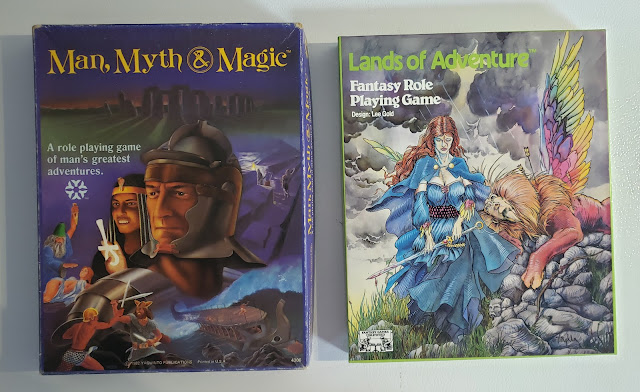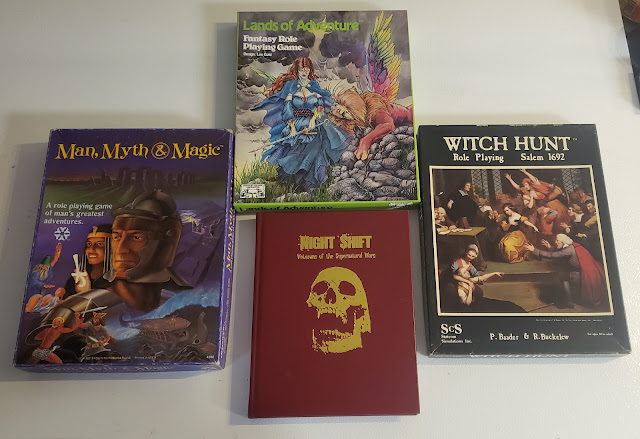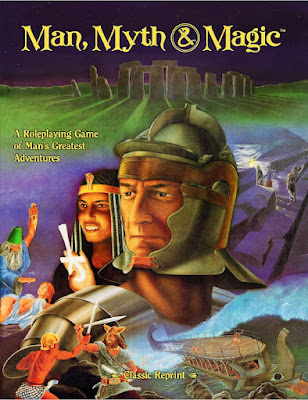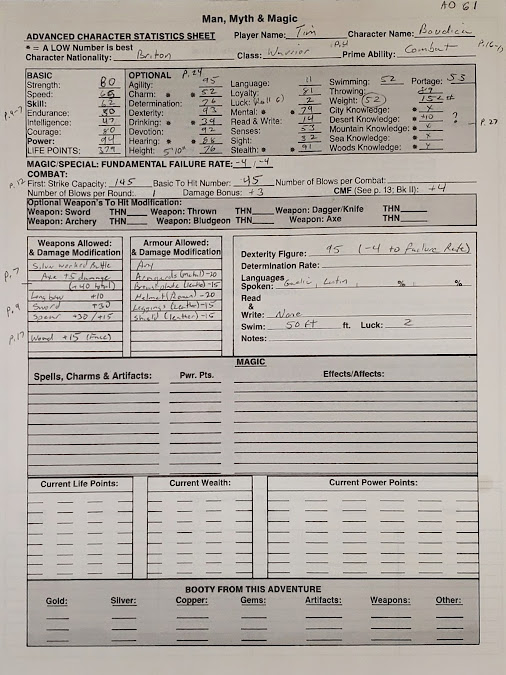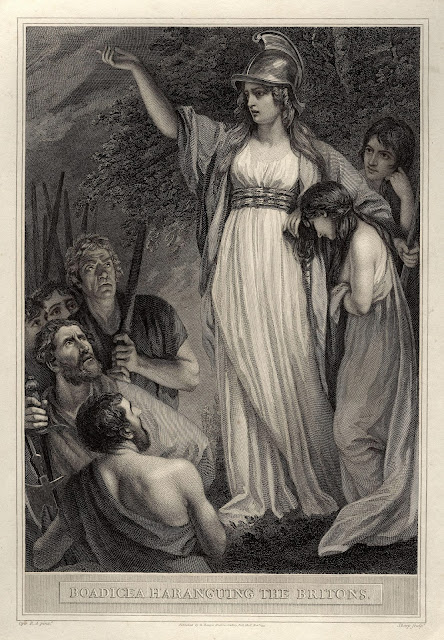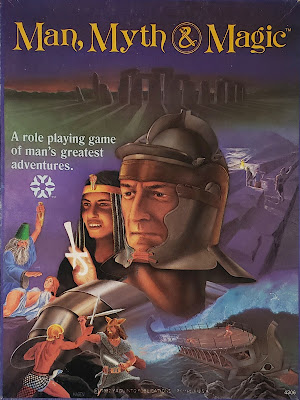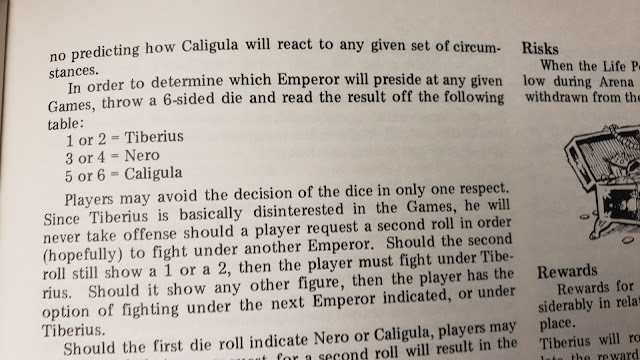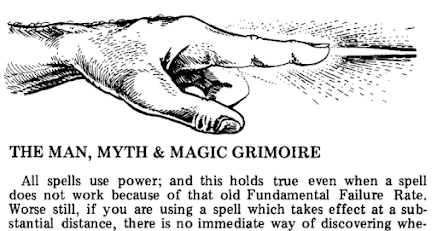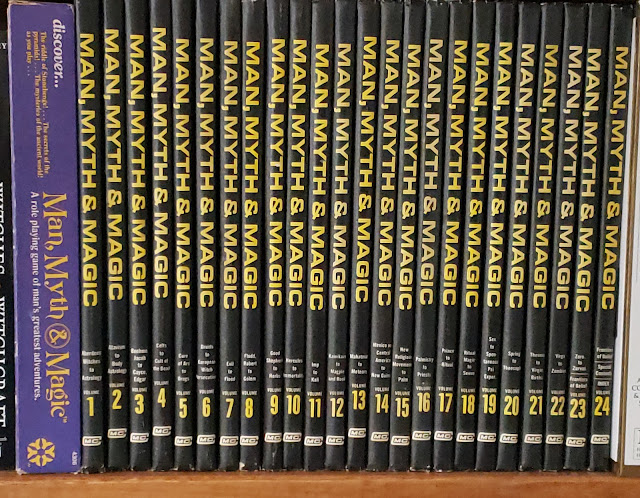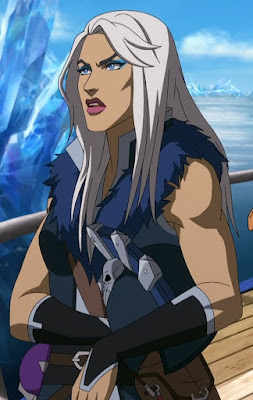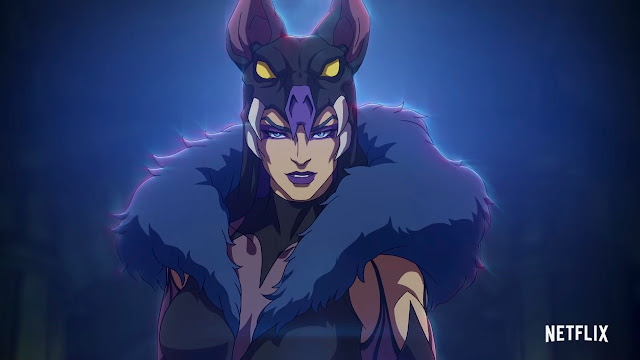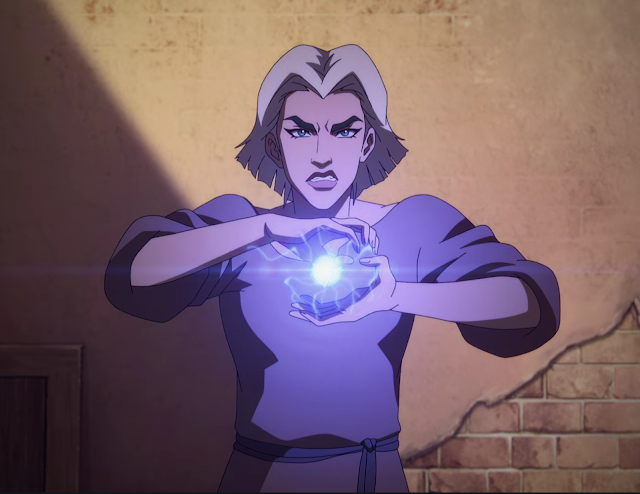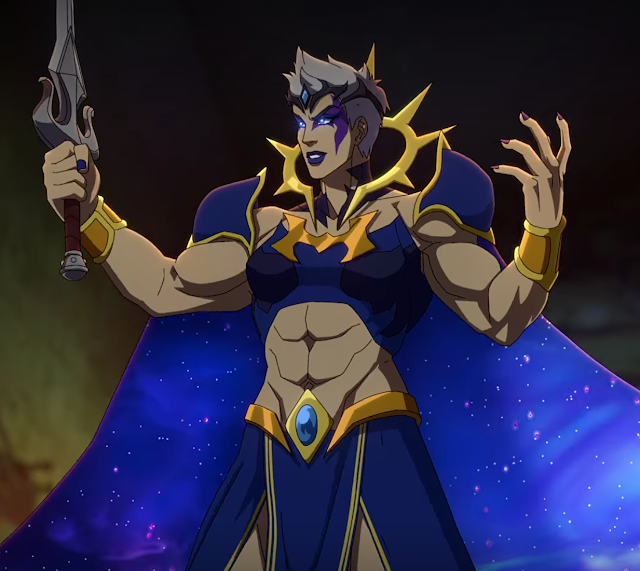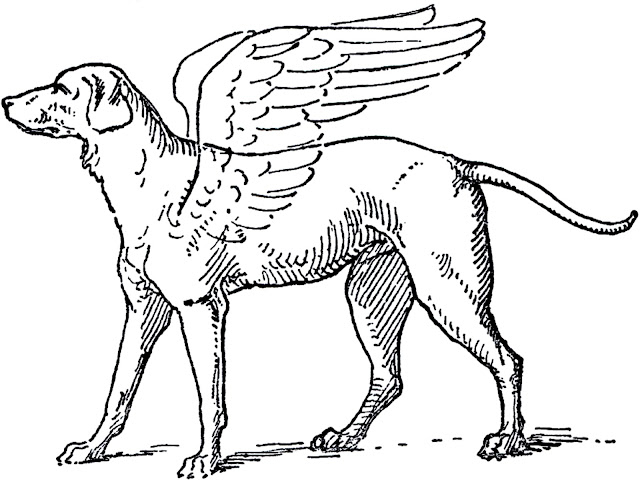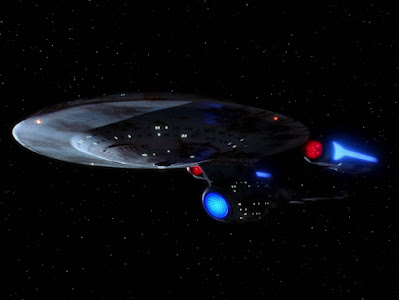
If
HARP Fantasy—first published by
Iron Crown Enterprises in 2003 as
High Adventure Role Playing or
HARP—can be seen as a lighter, more streamlined version of the publisher’s original roleplaying game,
Rolemaster, published in 1980, then
HARP SF can be seen as the publisher’s Science Fiction equivalent of
Space Master: The Roleplaying Game. All are percentile driven, Profession, Level, and Skills systems, but as with
HARP Fantasy, what
HARP SF is a fair degree of flexibility in terms of choices for both the player and the Game Master or SysOp—or Systems Operator as he is known in
HARP SF. A player is free to decide what Race his character is, what Professions his character follows, and what Skills his character knows, whereas the SysOp is free to decide whether or not to include psionics, cybernetics, and whether or not she wants to run
HARP SF in the setting included in the core book or one of her own devising. And even if she decides on the former, the SysOp has choices as to where she sets her campaign.
The default setting for
HARP SF is the twenty-fifth century. Mankind has built a Ring City around the Earth connected to the planet by a series of space elevators, and not only populated the Moon, Mars, and Venus—both Mars and Venus have been extensively terraformed, but also the outer system. Although the Lunar Alliance, the Martian Republic, the Protectorate of Venus, the Belter League, and the Jovian Confederacy all remain independent governments, along with the Parliament of Earth, they have signed the Declaration of Man, forming the Terran Federation and binding them to pact of mutual assistance, defence, and governance beyond their own borders. Almost three centuries later this still holds sway, every new colony expected to become a signatory. Since the discovery of the Lagrange Drive at almost the same time as the Declaration of Man was first signed, over a hundred colonies have been established within a fifty-light year sphere of Earth, but more have been founded since with the discovery a portal device which was capable of transporting a starship across the galaxy at a speed equal to one light year per minute—as opposed to the one light year per day speed of the Lagrange Drive. The other side of the portal lies some four hundred light years away from the Terran sphere of influence and it was here, in what became known as the Nexus sector (named after the first portal found), in the year 2454 that mankind made first contact. This was initially peaceful with various alien species, but raids by the aggressive reptilian Silth would escalate into an inadvertent raid in the solar system and the retaliatory Silth War by the Terran Federation in the Nexus sector which would curb the Silth activities. More recently, in 2464 a larger portal was found in the asteroid belt and a space station, Tintamar, established nearby to handle travel through and from the portal. It is this space station from which the default setting in
HARP SF takes its name.
The Tintamar setting is not hard Science Fiction per se, but harder than straight Space Opera. Technology is important, including Faster-Then-Light travel, anti-gravity technology, cyberware, and more, but not super-advanced technology like transporter devices capable of beaming people down to a planet and back again. Although the setting has cyberware, it is fundamentally positive in feel and tone, though far from a utopia. At the federal level, that of the Terran Federation, it leans towards being so, but the fact that planets and colonies retain their autonomy means that governments can vary from democracies and republics to theocracies and autocracies and unless the activities of a Terran Federation member spill over to another, the federal forces rarely intervene. Further pirates could be hiding out anywhere and the Silth still have designs for expanding their territory. Although the Tintamar setting is sketched out in relatively broad details, there are plenty of options as what the Game Master does with the setting. A humancentric campaign could be confined to the solar system and the sphere of human colonies, perhaps before first contact was made, whereas a broader setting that includes the presence of aliens would be set in the Nexus sector. Military campaigns could be fought against the Silth, an investigative campaign might be against the Terran Federation-wide crime Syndicate, and of course, the Player Characters could explore beyond the limits of human space. On the whole, the style and feel of
HARP SF, and of its Tintamar setting, is one of Imperial style Science Fiction even if there is no Imperium or empire present. Alternatively, the Player Characters could adventure in an alternative future of the SysOp’s own design.
A character in
HARP SF is defined by his Statistics, a Profession, Race, Culture, Skills, and Talents. A character has eight statistics—Strength, Constitution, Agility, Quickness, Self-Discipline, Reasoning, Insight, and Presence, which each has a value between one and one-hundred-and-five. There are eleven possible professions—Adept, Dilettante, Entertainer, Fusion, Merchant, Pilot, Researcher, Scout, Soldier, Spy, and Tech. Of these, the less obvious Adept studies and is capable of using psionics, and the Fusion combines the training of the Adept with another Profession. A Profession consists of Favoured Categories—the categories into which skills are grouped, such as Combat or Influence; Key Stats—those statistics favoured by the Profession; and one or more Professional Abilities unique to the Profession. For example, the key Statistics for the Pilot Profession are Agility, Insight, and Quickness, whilst its favoured skill category is vehicular, and its starting Professional Abilities a player can select from are Instinctive Evasion, Lightning Reflexes, Natural Astronaut, and Natural Gunner. At First Level, and then again at each Fifth Level, a Pilot also gains a +10% bonus to Vehicular skill.
In terms of Race, a player can choose from Human as well as five alien species. These include the inquisitive Krakur, amphibious, hexapodal, and tentacular, capable of changing their skin pigment and even separating a tentacle to perform a simple task; the short, pudgy Madji who have three eyes and multiple fingers on their hands, and who favour industrious co-operation; and the Runcori, intelligent, motile plants who can change shape slowly and have distributed senses all about their limbs, and who are brilliant scientists and technologists. The Cerans are large, muscular, but warm-blooded reptiles who have strong sense of territory—personal, intellectual, and social, whilst the Gorsivans are an avian-like species, intensely curious and often arrogant, capable of flight and possessing of telescopic vision. A sixth species, the cold-blooded, reptilian Silth are also given, but are only available as a Player Character species with the SysOp’s permission. Now what each Race provides are modifiers to a character’s Statistics, bonuses to his Endurance, Power Points, Resistances, Stamina, Will, and Magic, plus special abilities unique to each Race.
Also with a permission, a player can have his character possess genetic adaptations, represented by Genetic Talents, which model the character having adapted to the harsher conditions on which he was born. The Genetic Talents can be rated at major or minor, and a character needs to have the minor version before he can have the major, for example, High Gravity Adaptation would represent a character having grown up in a high gravity environment. If minor, High Gravity Adaptation would allow him to live under a gravity of up to 2g, whereas with the major version, it is up to 3g. Both grant bonuses to the character’s Strength, Quickness, and Constitution, but to have High Gravity Adaptation (Major), the character must also have High Gravity Adaptation (Minor). Typically, these are bought during character creation—and sometimes later during development when the character acquires a new Level—using Development Points.
HARP SF gives several Cultures—Aristocratic, Belter, Corporate, Cosmopolitan, Exotic, Frontier, Militaristic, and Scientific—each of which provides a basic language plus Skill Ranks gained as an adolescent. Skills come in nine categories—Artistic, Athletic, Combat, Concentration, General, Influence, Outdoor, Physical, Scientific, Subterfuge, Technical, and Vehicular—and are purchased in Ranks. There are some eighty or so skills, covering the sciences, technology and engineering, the arts, piloting, combat styles and manoeuvres, and so much more. Some of the slightly odder skills include Armour (training in to move and fight in armour to negate its lack of flexibility and its bulk), the Two Gun Combo Combat Style, Cyber Control (required to use particular types of cyberware, such as cybersenses or cyberlegs), Frenzy (essentially, going berserk), and Rope Mastery, but otherwise, the skills included are all appropriate to the genre! Lastly, a character can have Talents, such Biosculpted Body, Fast Fixer, Increased Lung Capacity, or Radiation Resistance.
To create a character, a player generates the Statistics, either by rolling dice or purchasing them with points, and then selecting a Race and Culture. Each character receives a pool of Development Points, modified by their Statistics, with which to purchase Skills and Talents. A limited number of Development Points can be spent to improve a character’s Statistics. There are oddities in the system which require the player to spend Development Points if he is to improve certain aspects of his character. One is that despite
HARP SF being a Profession (Class) and Level system, a player does not simply roll his character’s Hit Points, but purchases the Endurance skill and its final value is how damage a character can have. A player will also need to put Development Points into Psi Energy Development if he wants his character to be able to use psionics, this in addition to purchasing active and latent psionic abilities. Even odder though, is the fact that the character’s Resistance Rolls—Stamina, Will, and Magic—are also skills and again can be improved by a player spending Development Points on them. Both Endurance and the Resistances have base values derived from a character’s Race, so there is a minimum value built into the mechanics. What this points to though, is how little a character’s Level has on the character—primarily it places a cap on how many Ranks a character has in any one skill and when and how many Development Points a character gains—and the degree of freedom a player has to build and modify his character.
Each time a character gains a Level—through earning Experience Points—the player acquires further Development Points with which to improve his character. He also gets the bonus Development Points as the character had at First Level and because these are derived from a character’s Statistics, it does mean that characters with better Statistics will develop faster and better in the long term.
Our sample character is Hurik, who grew up on Earth’s Ring City where life was easy. Having no real plans for a career, he attended for the Colony Resettlement Programme and attended Colony College, deciding that he wanted to do something different and see more than what home offered. He discovered that he like animals and growing things, and if he cannot have his own farm out on the frontier, then he wants to work on one.
Hurik
Race: Human
Gender: Male Age: 20
Height: 5’ 6” Weight: 136 lbs.
Culture: Cosmopolitan
Level 1 Scout
Strength 79 (+6) Constitution 90 (+8) Agility 56 (+2)
Quickness 44 (-2) Self-Discipline 60 (+2) Reasoning 52 (+1)
Insight 75 (+5) Presence 46 (+0)
Resistances
Stamina 0 (+10), Will 0 (+10), and Magic 0 (+10)
Endurance 80
Defence Bonus -4
Skills
Artistic: Painting 6 (+40)
Athletic: Climbing 1 (+13), Wrestling 1 (+15)
Combat: Brawling 2 (+18), Modern Ranged 2 (+18)
General: Appraisal 1 (+11), Computer Operation 2 (+16), Linguistics Anglic (Spoken) 6 (+36), Linguistics Anglic (Written) 6 (+36), Linguistics Other Species – Madji (Spoken) 4 (+00), Linguistics Other Species – Madji (Written) 3 (+16), Machine Operation 1 (+08), Mundane Lore: Own Culture 1 (+07), Mundane Lore: Cosmography 2 (+12), Mundane Lore: Geography 1 (+07), Perception 5 (+32), Resistance – Stamina 1 (+21), Rope Mastery 5 (+28), Vocation (Administration) 2 (+16)
Influence: Charm 1 (+10)
Outdoors: Animal Handling 6 (+35), Beast Mastery 6 (+35), Foraging/Survival 6 (+36), Horticulture 11 (+58), Navigation 6 (+36), Tracking 6 (+37)
Scientific: Biology 1 (+11)
Physical: Endurance 6 (+50), Jumping 1 (+13), Swimming 1 (+13)
Subterfuge: Camouflage 5 (+32), Sniping 5 (+29), Stalking & Hiding 5 (+29), Streetwise 1 (+10)
Technical: Engineering 1 (+11)
Vehicular: Driving (Conventional) 3 (+22)
Special Abilities
Bonus Skill Ranks (+5 Ranks), Profession Adaptation
Professional Abilities
Toughness (+10% Endurance)
Equipment (1005 credits)
Hunting Rifle with Scope, Handheld Computer, Personal Communicator, Backpack, All-Weather Bag, All-Weather Tent, Inertial Compass, Firelighter, Rope, Spade
Much like
HARP Fantasy, the character creation process in
HARP SF is neither fast nor easy, and in comparison to contemporary roleplaying games, it is actually cumbersome, especially once you figure adding psionics, which everyone can have access to. Finding everything in the book is also something of a struggle to the point where it hampers the process. Nevertheless, the process is comprehensive and a player will be able to produce the desired character at the end of it—just one of the benefits of
HARP SF—plenty of options and no little flexibility in what sort of character a player could create. This is further enhanced with the use of Training Packages, limited groups of skills that represent a profession, guild apprenticeship, and so on. So, it might be Entrepreneur, Netrunner, Starsoldier, or Xenoarchaeologist, for example. Such packages are available at a discount, can be taken only the once per Level, and a player is free to design his own, with of course, the Game Master’s consent. Now the Game Master could also design his own and use those to help provide a place and occupation in his world for player characters and NPCs alike.
Being a Science Fiction roleplaying game,
HARP SF encompasses a wide range of technology. It grades its technology levels at Unavailable, Prototype, Early, Mature, Advanced, and Obsolescent, rather than a numerical rating, which is actually easier to grasp on a case-by-case basis, and more obviously offers roleplaying and storytelling tags than just the plain numbers. The range of technology available covers neurowhips, vibroknives, blasters, lasers, needle guns, electrostunners, DNA scanners, poison sniffers, arterial fixers, skeletal healers, infrared contact lenses, laser listeners, inertial compasses, environment tents, and much, much more. All of this is rated at the Mature grade in
HARP SF’s default Tintamar setting. Rules cover miniaturising and combining equipment too, although doing either will cost more.
Adventuring in
HARP SF of course has to cover a wide variety of situations and conditions, since after all, it is a Science Fiction game. Computer issues, diseases and poisons, equipment—uses and limits, sensors, scanners, and countermeasures, occupational hazards and environments, and more are covered in sufficient detail in the likely event that they arise in play, although the rules do get more complex than you might expect when having to determine terminal velocity, sensor ranges, and the like. Here a bit more arithmetic creeps in than perhaps it should since working out the results of an equation at the table is not going to appeal to everyone. Nevertheless, the core mechanic in
HARP SF is straightforward enough. When he wants his character to undertake an action or Manoeuvre, a player rolls the percentile dice and adds the character’s appropriate skill, whether that is Rope Mastery, Machine Operation, Ranged Weapon, and so on, and if the result is over one hundred, then the action or task has been done with complete success. Modifiers can apply, whether from the situation or equipment, as well as the difficulty. If the roll is open-ended, any roll of ninety-six and above on the dice, means that the player roll again and add the result. Even if a Manoeuvre attempt does not completely succeed, the result can also determine to partial degree of success—measured as a percentage on the Manoeuvre Table, which is useful if a Manoeuvre involves a time factor. In addition, the Manoeuvre Table can also determine whether the outcome of a Manoeuvre is a fumble—generally a roll of ten or less on the percentile dice, and depending upon the nature of the action, the Fumble table covers everything from grenade fumbles, melee combat fumbles, and ranged combat fumbles to physical fumbles, psionics fumbles, and vehicular fumbles.
Combat uses the same mechanics, and is generally more complex than the standard rules—and understandably so, since it has to encompass a greater number of variables, including multiple differing weapon and armour types. Initiative is rolled a single ten-sided die plus modifiers from Statistics, encumbrance, and the situation, rolled at the beginning of each two-second turn during which a character will perform one action, whether that be draw a weapon, attack, stand up, or move, or a combat action. All attack rolls are open-ended, to which the attacker adds his Offensive Bonus—determined by skill, statistic, talents, weapon, and positional bonuses, plus range and situational modifiers for range, and then subtracting the defender’s Defensive Bonus—determined by the Quickness statistic and armour, shield, talents, cover, Manoeuvre, equipment quality, and situational bonuses. If the result—the Total Attack Roll—is equal to one or more, then the attacker has hit the defender. It can be further modified by weapon size to give an Adjusted Attack Roll and it is this result which is compared to the Critical Table for the weapon type used. In
HARP SF, there are Critical Tables for Crush, Puncture, Slash, Martial Arts Strikes, Martial Arts Sweeps/Unbalancing, Grapple, Cold, Heat, Electrical, Impact, External Poison, Internal Poison, Large, Huge, Ballistic Impact, Ballistic Puncture, Blaster, Laser, Neuro, Plasma, Radiation, Shrapnel, and Vacuum attacks. Essentially what
HARP SF does is combine the attack roll with the critical results tables of the much earlier Rolemaster or
Space Master, effectively streamlining them. Overall, the combat rules are comprehensive, but despite being supported by numerous examples, do require a close study. Certainly, the SysOp should work through several examples of her own before attempting to run them at the table.
Penultimately,
HARP SF covers psionics, which come in variety of disciplines whose effects can be observed, but not adequately explained by science. They are divided into various fields—Biokinesis, Electrokinesis, Extrasensory Perception, Psychokinesis, and Telepathy. These are further broken down into disciplines, with characters possessing Latent Psionic Fields before Active Psionic Fields. The Adept and Fusion Professions have greater access to Psionics, though any character can have them by expending Development Points. The more Psionic Fields—Latent or Active—a character has, the more expensive they are to purchase. Each Psionic Discipline requires two things to activate. First, Psionic Energy Points, the number of which can be increased with the Psi Energy Development skill, and second the related Psionic Discipline skill. It is fair to say that much like magic in
HARP Fantasy, psionics in
HARP SF really require their own discipline to study and understand how they work and how they play in game.
Lastly, there are guidelines for the SysOp too, starting with ‘Have Fun!’ and ‘Know the rules!’. There is good advice here, though ‘Know the rules!’ is most obviously pertinent primarily because of their relative complexity in parts and the challenge of the imparting an understanding to the players despite that complexity. Similarly, the advice to ‘Work out the math in advance’, specifically when dealing with space-based combat, highlights the complexity of
HARP SF. There is advice too on customising the SysOp’s game and some suggestions as possible campaign ideas and adventure seeds. Some of the roleplaying game’s more useful tables are printed at the back of the book.
However, there are elements missing from
HARP SF and it is not complete in its treatment of the genre. It does not cover vehicles or vehicular combat in space or on the ground, and there is little in the way of cyberware or coverage of advanced computing. For that, the
HARP SF Xtreme is required and is very much the companion or other half to
HARP SF. That said, the contents of
HARP SF would stand on their own to an extent, depending on how the gaming group wants to handle vehicles. It would result in a very planetary-based campaign, with travel between systems done as story rather than action, or even done via portals. Even then, what
HARP SF does not have is rules or guidelines for creating worlds and systems, or indeed alien species, and again, the SysOp will likely need to create those without referring to rules or guidelines. What that means is
HARP SF is not the toolkit that it could have been for the SysOp to create of her own, and that
HARP SF Xtreme is a must buy purchase.
Physically,
HARP SF is a plain, simple, greyscale book. The artwork is decent and the writing is clear and easy to read—for the most part. The game’s many examples of the rules are presented using light grey rather than black. This makes the examples difficult to read. In addition, the book’s numerous tables are often also too small to read. Another issue is the organisation of those tables. They are not repeated for easy access at the back of the book, for example, the Critical Tables for the various attack types, so the SysOp will need to bookmark the tables that get referenced a great deal during play, if not purchase or create his own reference screen. The book could have been slightly better organised in that the need to purchase Endurance, Power Point Development, and the Resistances as skills could been made more obvious, if not explicit. They are essentially buried in the skills section when they needed to be highlighted as part of the character creation process.
In comparison to the much earlier
Space Master, it is clear that a great deal of effort has been put into making
HARP SF a much more streamlined and simpler Science Fiction roleplaying game. However it cannot avoid a degree of complexity in places, especially the psionics rules which feel like a subsystem of their own, and so this does mean that
HARP SF is still a challenge to really teach the players even once the SysOp has grasped how it works. In comparison to
HARP Fantasy, which felt somewhat generic in its treatment of the fantasy genre,
HARP SF does not, the Tintamar setting suggested a low Space Opera setting in which technology plays an important role rather than high Space Opera where the Player Characters push buttons and the spaceship just goes. The mechanics to
HARP SF do suggest a harder edge to its Science Fiction though, which is slightly at odds with the setting. Nevertheless, its setting of Tintamar offers plenty of scope for gaming and expansion, and if a gaming group can pick the rules up,
HARP SF offers a solid range of options and flexibility in terms of characters, combat, and even campaign frameworks.



